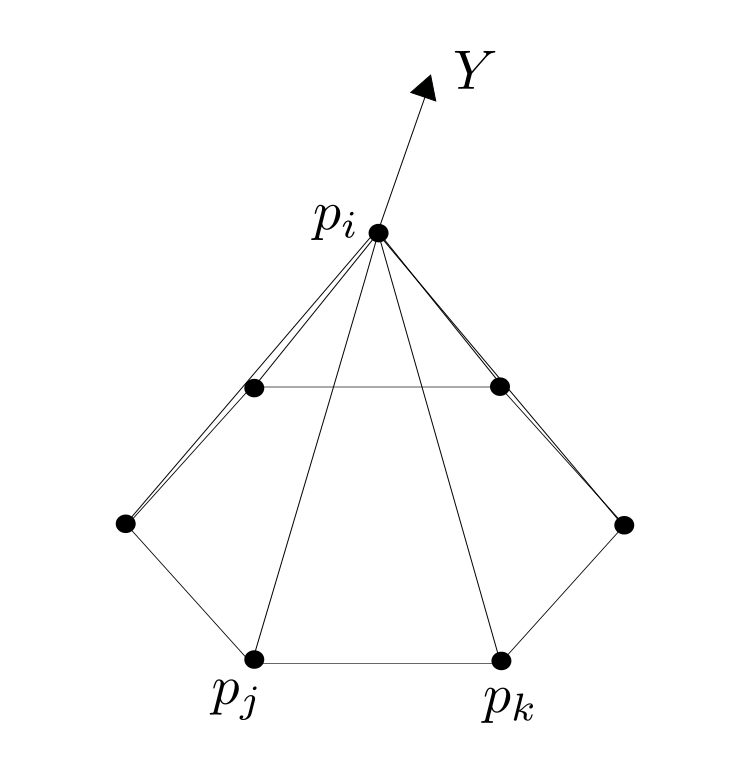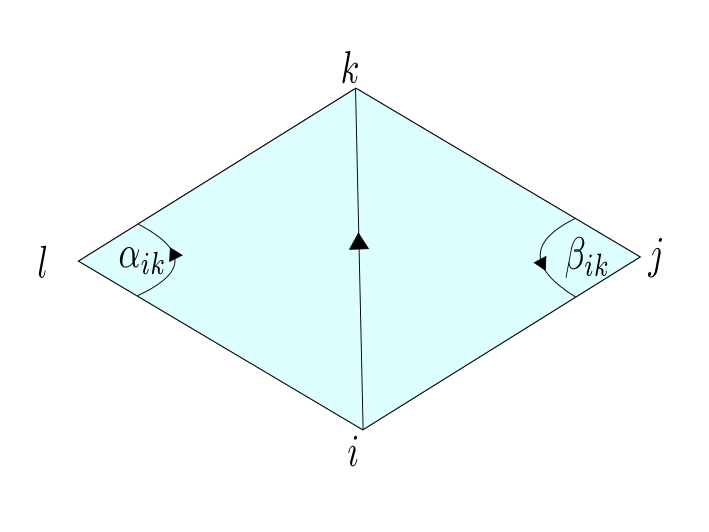Let be a triangulated surface (with boundary). A realization of the surface in is given by a map such that form a non degenerated triangle in for all , (i.e. do not lie on a line). Some problems, like the plateau problem do not depend on the position of the vertices in the space, but only on the length of the edges:
If we have a realization of the surface in there holds: and the edge length’s satisfy the triangle inequalities:
Definition: A metric on a triangulated surface assigns a length to each oriented edge such that the triangle inequalities are satisfied.
 Note that every realization induces a metric on the underlying triangulated surface. On the other hand a triangulated surface with metric has several realization in , such that the metrics coincide. On a triangulated surface with metric every triangle has the structure of an euclidean triangle in , that allows us to interpolate to a piecewise affine function and define the Dirichlet energy as in the last lectures.
Note that every realization induces a metric on the underlying triangulated surface. On the other hand a triangulated surface with metric has several realization in , such that the metrics coincide. On a triangulated surface with metric every triangle has the structure of an euclidean triangle in , that allows us to interpolate to a piecewise affine function and define the Dirichlet energy as in the last lectures.
In particular, we can define angles and area using the cosine theorem:
By the triangle inequalities we obtain that and the angles are well defined. With we can define the cotangents weights and the area of the triangle :
For a realization of with vertex positions and edges we obtain for :
and the total area is give by:
Definition: The following problem is the Plateau problem: Let be a triangulated surface with boundary and a prescribed function. We are looking for a realization of such that:
1.
2. has the smallest area among all realizations of , with .
In order to be able to solve the Plateau problem we have to consider variations of :
Definition: A variation of with constant boundary assigns to each vertex a curve such that:
1. for all
2. for all if .
Definition: is called a minimal surface if it is a critical point of the area functional, i.e. :
for all variations of with constant boundary.
Lemma: is a minimal surface if and only if For each and each curve we have:
I.e. is a critical point of the area functional with respect to all variations with constant boundary, if and only if it is a critical point for all those variations that only move one interior vertex.
Proof: clear.
Similar to the following fact from analysis:
All directional derivatives of a function vanish at if and only if all partial derivatives of vanish at .
Theorem: is a minimal surface if and only if all tree components of are discrete harmonic functions with respect to the metric induced on by .
Proof:  Fix and let be a variation, that only moves and Further we define to be the set of positive oriented triangles that contain the vertex . We have to show that there holds:
Fix and let be a variation, that only moves and Further we define to be the set of positive oriented triangles that contain the vertex . We have to show that there holds:
Before we start with the proof remember these identities from analysislinear algebra
1. For a function there holds:
2. For we have:
With we get and can compute now the variation of the area functional:
With
and
We have:

In an earlier lecture we showed that: and
With an index shift in the first sum we have now :
Since this has to hold for all variations of and for all we finally get:
This means is an minimal surface if and only if all components of are harmonic with respect to the metric on induced by .
 Note that every realization
Note that every realization  Fix
Fix 
